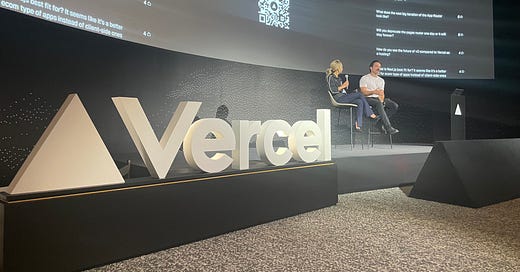Adopting AI: patterns and tensions in the wants/needs of software company’s leaders and their teams
Observations from the field: what I learned from Stripe Sessions, Vercel Ship, the UBS Women in Tech Summit, and AI Crafts Boulder's recent meetup.
In the past couple of months, I’ve prioritized learning as much as I can about the challenges technical leaders and their teams face when building software products. To do this, I attended several conferences and workshops including Stripe Sessions and the UBS Women in Tech Summit in SF and the Vercel Ship conference in NYC. Just last week, I attended an AI Crafts Boulder meetup locally on mastering AI in Product Development.
Across numerous sessions and conversations, several notable patterns emerged. Technical leaders today are facing increased pressure from other C-suite leaders to adopt AI tooling to reduce cost and increase their team’s productivity. Improving operational efficiency is top of mind for the C-Suite in the current market. These leaders want AI solutions to increase development speed, improve productivity, and reduce costs, while maintaining quality. Their organizations are already adopting AI tools for their software development. For example, Microsoft Copilot already has 1M paid users in 37K organizations while still in beta. And GitHub Copilot, their tool specifically for developers, recently saw 40% quarter over quarter growth (source).
However, there’s often a disconnect between the C-suite’s expectations of AI’s capabilities and the reality of using AI for software development today. While tools like GitHub Copilot and Cursor or even Devin are promising, they are not yet capable of doing more than assisting a developer and sometimes have steep learning curves. Several technical leaders mentioned concerns around if developers leveraging AI without sufficient context or software development experience, then these tools can introduce more harm than good. Code might not follow best practices, no one (including the developer who created the code with AI) can easily understand how it works, and unexpected issues often arise. One technical manager mentioned that senior developers on their team were now less productive, because they needed to spend more time reviewing and debugging their less experienced teammates' code after they started using AI.
Despite some early challenges, there is still a lot of excitement and hope around AI code generation tools. At the Vercel Ship conference in NYC, several of the presenters shared sneak peeks of how v0 might accelerate software creation in the earliest stages of a new project and many of the attendees expressed appreciation for a tool that might help them better evaluate model performance. For example, in the closing Q&A with Guillermo Rauch, the CEO of Vercel:
Both today and in a future where AI becomes more widely adopted as part of the code creation process, software teams need to understand and test changes. Figuring this out today typically requires a lot of manual effort. On our team, this looks like sharing demos of changes or testing changes before and after pushing them to production. In a world where more AI is being used to write code, being able to easily parse and understand the intended impact of the code becomes even more critical.
How do you do this? I believe software simulation is the solution. This is what inspired our team to being exploring something new: CodeYam. Our vision is to accelerate software development by improving how you track, understand, validate, share, test, reuse and maintain code. To this end, we are building a software simulator that automatically reads code and generates data to simulate the code in various scenarios. While still early, we believe this has the potential to save tremendous amounts of manual effort for developers and their collaborators, accelerating software development while reducing the cost and effort required.
This desire to craft great software products faster is why we are building CodeYam. Our goal is to help technical leaders and their teams accelerate software development and improve quality while reducing cost to deliver great software products.
If the idea of software simulation is relevant to you, we’d love to get your feedback. You can join our waitlist for CodeYam on our website, or sign up to receive blog updates on CodeYam’s Substack.
And if you’re interested in more of my personal musings, you can subscribe below.




